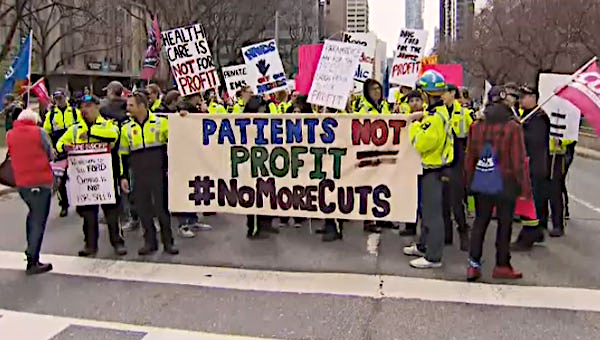City Manager Peter Wallace recently released a report on The City of Toronto’s Long-term Financial Direction. The analysis is the latest to reinforce what many earlier studies have long been arguing: that the city of Toronto does not have a spending crisis, but a revenue crisis. It found that “cost containment” measures have produced some $300-million in savings since 2010, but that this has done little to address the structural deficit at the root of the city’s financial challenges. The report notes that, consistent with the austerity approaches adopted by the governments of Ontario and Canada, city government is less expensive today than it was six years ago: some $165 or 3.8 per cent less per resident (in 2016 dollars). And yet, despite austerity targets totaling some 16 per cent over six years, and the elimination of 1,374 positions, the City has been unable to stop, let alone reverse, the growing revenue crisis that has been a hallmark of urban governance.
Wallace’s report also found that when adjusted for price inflation property taxes have actually fallen 4.8 per cent since 2010, the lowest of any major city in Ontario. At the same time, TTC fares have risen more than 17 per cent, recreational programs and permitting are up 9 per cent, while waste, water and parking have jumped 24 per cent. The practice of deferring capital expenses has also continued apace and is now conservatively estimated to leave the city $1-billion short per year of its needs by 2021. Should any number of uncertain revenue streams dry up, such as the land transfer tax which is up 167 per cent, this could significantly raise the revenue gap. Other pressures include: funding requirements for the TTC and Toronto Community Housing, annualized costs related to earlier capital and operating commitments, addressing prior year deferrals of employee benefit liabilities, and adjustments in response to the loss of the Toronto Pooling Compensation grant from the Ontario government, let alone council promises to implement its poverty reduction strategy, clamp down on runaway police budgets, and address the inadequacy of social assistance. As Wallace makes clear: “operating expenses are not simply government spending for its own sake – they are investments of vital public resources by Council toward a broader public good. Similarly, capital investments address issues around livability, congestion and public space in our dynamic and increasingly dense and complex city.”
As the analysis argues, there are no quick solutions or shortcuts to be found: annual surpluses are falling and an inadequate capital finance strategy, reserve funds are already at historically low levels compared to other jurisdictions and, although funding from other orders of government are important and necessary, they cannot replace long-term gaps in operational funding or fully offset unmet capital needs. And, even though the highly uneven pattern of settlements with City workers has been falling below the rate of inflation, expenses tend to climb moderately over time. As Wallace concludes in no uncertain terms, the “circumstances of the recent past are unlikely to continue and, at the very least, cannot form the basis for responsible future fiscal planning.” Indeed, “It is no longer appropriate or feasible to defer difficult financial decisions to future years. The time has come for a direct conversation concerning the City’s finances.”
Breaking the cycle of permanent austerity and retrenchment that has characterized the last three decades of urban neoliberalism in Ontario requires challenging the continued reliance on tax cuts as a cure for nearly all of society’s social ills, as well as an alternative vision of municipal governance that rejects the market-based remaking of urban life. In addition to expanded revenue transfers from federal and provincial governments, a variety of independent revenue tools are needed if municipalities are going to become fiscally autonomous governance units. In an attempt to address the municipal malaise, mainstream approaches have tended to focus on increasing the scope of market imperatives through a continued ideological and political assault against public services and public sector workers (cfib 2013; University of Toronto Mowat Centre–kpmg 2009). At the same time, business and development groups continue to influence municipal councils through lobbying, local business associations and bankrolling local campaigns for office. These much-recycled approaches, however, rather than addressing municipalities’ structural constraints, reinforce their worst effects. Substantively addressing the revenue crisis that currently besieges municipalities, then, requires an alternative approach rooted in social equity, inclusiveness and justice.
Overcoming the Myth of Fiscal Crisis
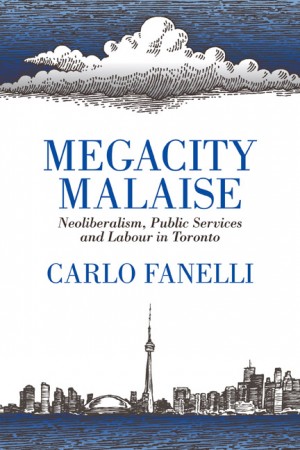 The discourse of fiscal crisis is part fact and part fiction. But it is important to separate its economic realities from political pretexts. Because Ontario municipalities are effectively barred by provincial legislation from running annual deficits, many municipalities are on
The discourse of fiscal crisis is part fact and part fiction. But it is important to separate its economic realities from political pretexts. Because Ontario municipalities are effectively barred by provincial legislation from running annual deficits, many municipalities are on
firmer fiscal ground than their provincial and federal counterparts, as is evidenced by balanced operating budgets, manageable levels of borrowing, low debt overhangs and strong credit ratings. While there is much variability across Ontario municipalities, Slack, Tassonyi and Grad (2014) argue that Ontario’s thirty largest municipalities have been fiscally prudent and conservative over the period from 2000 to 2011, thus are efficiently managed and generally well run. They also note a growing disparity between older industrial city–regions (Niagara Falls, Hamilton, Windsor) and northern municipalities (Sudbury, Thunder Bay, Sault Ste. Marie) on the one hand, and GTA municipalities (Vaughan, Mississauga, Oakville) on the other, in their ability to raise revenues, their varied dependencies on provincial–federal transfers, pressures on infrastructure and demands for social services. While the former are often dealing with an older and declining population, weak economic growth and, in some cases, harsher climates and geographic remoteness, the latter are growing in population, more economically robust and experiencing a construction boom, thus broadening the property tax base. Hence, there is an unevenness in the Ontario urban and regional political economy.
Two of the foremost authorities on municipal finances, Enid Slack and Andre Cote (2014), have argued that Toronto does not have a spending problem, but rather a revenue problem. Their research demonstrates that, despite the perception that spending has been rapidly growing, in reality expenditures per household are roughly equivalent to what they were in 2000, when adjusted for inflation and population growth. However, there have been some important changes in the allocation of expenditures: while transportation costs grew as a share of operating spending from 21 to 28 per cent, and police and fire services have remained constant at 16 per cent, social and family services – including social assistance, childcare and seniors’ programs – declined from 27 to 20 per cent as a share of total spending. This is equal to more than a 25 per cent real cut in social and family services (Slack and Cote 2014: 3).
Much like the Miller-era Independent Fiscal Review Panel and Ford-era Core Services Review, Slack and her colleagues’ work confirms that there are few, if any, remaining efficiencies to be found without lowering services levels or asset sell offs. Property taxes are a very visible and therefore particularly contentious tax as the impression persists that rates have been rising rapidly. Although property taxes account for some 40 per cent of the City’s revenue, with provincial and federal transfers worth some 20 per cent, when adjusted for inflation and population growth, Toronto’s property tax revenues per household have actually fallen by nearly 15 per cent between 2001 and 2012, and are amongst the lowest in the GTA. Commercial, industrial and multi-residential taxes are also on their way down and tax increases for these groups have been limited to one-third of residential tax increases. After more than a decade of comparatively low development charges across the GTA, Toronto development charges were finally increased in 2013 in order to account for the rising costs of providing infrastructure for new residential developments (Slack and Cote 2014: 10–14). However, while development charges assist in supporting new infrastructure they do not support long-term operations, maintenance and replacement. Also, the assessed property tax is unlikely to generate enough to cover the costs. As a consequence, the burden of paying for aging infrastructure is shifted from both the private to public sector and from business to workers.
In light of Toronto’s construction boom, which some are warning appears to be vastly overvalued (McMahon 2014), the Land Transfer Tax rose from $150-million in 2009 to $350-million in 2013. The combined value of the City’s assets total nearly $70-billion, excluding land
and parkland values. This includes everything from water and wastewater systems, transportation infrastructure, public transit, city buildings, facilities, fleet and public housing. However, pressures to sell off these assets are mounting as a result of the financial inability to maintain and renew existing assets, and build new ones to accommodate population and service level needs (Grewel 2011; Sancton 1996). Estimates suggest that Toronto’s infrastructure deficit will climb from $2-billion in 2013 to $2.4-billion by 2020, as much of the infrastructure built during the 1950s and 1960s goes unrepaired. Likewise, a repair backlog for social housing estimated at $860-million is expected to rise, with $2.6-billion in capital funding needed over the next decade. This structural shortfall is not the result of overgenerous social services or the excessive wages of unionized employees. Rather, they are a legacy of growing, long-term pressures resulting from population growth and downloaded infrastructure and public service costs from provincial and federal governments, especially for transit and housing. Thus Toronto is a city that has both a housing boom and housing crisis existing in tandem.
How to provide quality, affordable housing is, of course, a complex multilateral issue. In general, however, the City of Toronto (as elsewhere) has preferred voluntaristic agreements and incentives for developers, rather than mandatory measures. As noted earlier, given
municipalities’ limited financial capacities they are constrained in their abilities to build and operate housing facilities as well as programs that address the lack of affordable housing and homelessness. This does not, however, mean that municipalities are impotent. They can examine their own regulations to eliminate barriers to the provision of affordable housing, including the legalization of secondary units, new density agreements for affordable and rental housing, the provision of land for emergency/transition/supportive/belowmarket housing, prohibiting the conversion of rental suites and charging a dedicated development levy that goes into a fund for affordable housing. Municipalities can also enhance planning and zoning support, regulation and business licensing; design levies to discourage quick “flipping” and housing market speculation; fine owners of long-term empty “investment” properties; and strengthen by-laws and building regulations. New measures by other levels of government, including new regional coordination and municipal governance capacities, are of course also necessary, such as changes to tax policy to encourage the construction of rental housing, strengthening of existing legislation, maintaining and expanding existing funding programs for homelessness and affordable housing, and inducements for non-profit and cooperative housing. One such measure is an inclusionary zoning policy mandating 10 to 15 per cent of all units in large residential buildings be set aside for affordable housing. In fact, since amalgamation, the City has requested more than a dozen times the administrative power to use inclusionary zoning. And yet, despite some 95,000 households on the city’s affordable housing waiting list, the Province has refused to devolve such powers. Although inclusionary zoning will not resolve Toronto’s housing crisis, it will offset some pressures. New investments from federal and provincial governments will also be necessary in order to begin addressing the shortage of affordable housing. However, since transfers are out of municipalities’ hands, there is little certainty about future funding and uploading of costs.
Reimagining the Municipal Bargain
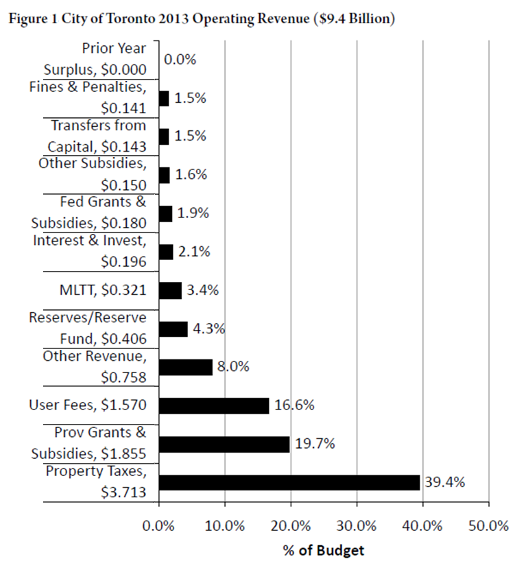 In order to counter the municipal race to the bottom, it is necessary to change the social attitudes about the role of taxation and make the connections between social justice and workplace democracy. Ontario municipalities’ current reliance on property taxes is unsustainable in the long run and merely shifts the burden of responsibility for social and physical infrastructure from one generation to the next, and from capital to labour. While increasing municipal development charges is an important revenue initiative, it tends to be cyclical in nature and relies on the unstable fluctuations of real estate markets. It is necessary, therefore, to establish dedicated funding to municipalities by other tiers of government as well as independent revenue-raising capacities. The fiscal mechanism for this is straightforward in a sense of reversing corporate and personal income tax cuts implemented since at least 2008 and raising the GST back to 7 per cent, with dedicated funding to municipalities. These measures could provide consistent and secure funding, which could begin to redress decades of underinvestment and neglect across Canadian municipalities. Turning to wealthy individuals and corporations, who have benefited the most from neoliberal tax reforms, and having them contribute a fairer share in terms of higher corporate and income taxes, would be a symbolic and significant initial step. But wider populist, anti-tax sentiments must also be challenged, so that more goods and services come through public, and not private, consumption.
In order to counter the municipal race to the bottom, it is necessary to change the social attitudes about the role of taxation and make the connections between social justice and workplace democracy. Ontario municipalities’ current reliance on property taxes is unsustainable in the long run and merely shifts the burden of responsibility for social and physical infrastructure from one generation to the next, and from capital to labour. While increasing municipal development charges is an important revenue initiative, it tends to be cyclical in nature and relies on the unstable fluctuations of real estate markets. It is necessary, therefore, to establish dedicated funding to municipalities by other tiers of government as well as independent revenue-raising capacities. The fiscal mechanism for this is straightforward in a sense of reversing corporate and personal income tax cuts implemented since at least 2008 and raising the GST back to 7 per cent, with dedicated funding to municipalities. These measures could provide consistent and secure funding, which could begin to redress decades of underinvestment and neglect across Canadian municipalities. Turning to wealthy individuals and corporations, who have benefited the most from neoliberal tax reforms, and having them contribute a fairer share in terms of higher corporate and income taxes, would be a symbolic and significant initial step. But wider populist, anti-tax sentiments must also be challenged, so that more goods and services come through public, and not private, consumption.
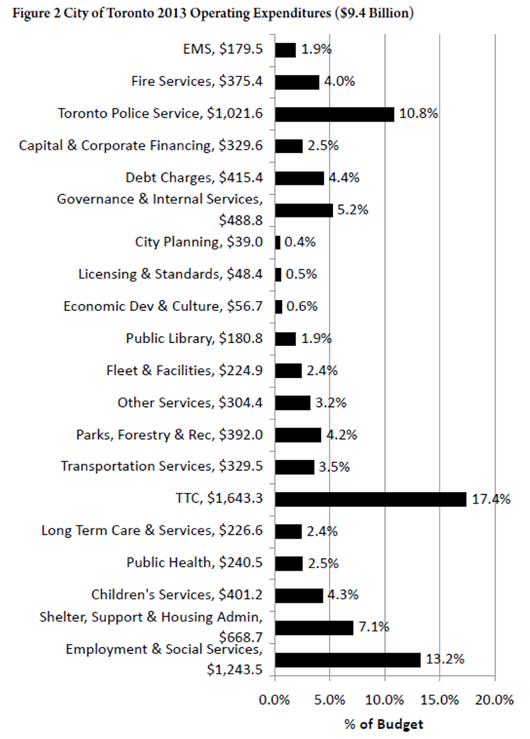 As Figure 1 shows, despite the City of Toronto having a broader range of revenue tools than other Ontario municipalities, it continues to overwhelmingly rely on property taxes to raise revenue outside of federal and provincial transfers. And from this, as Figure 2 demonstrates, the City must provide a range of services including general government administration, social assistance, health services, social housing, fire and police services, long-term care, shelters, libraries, parks, recreation and so forth. Hence, an alternative municipal agenda also needs to consider a broader range of options for mobilizing revenues beyond property taxes. This is especially the case so that user fees can be cut and eliminated for many services as part of broader social equity initiatives.
As Figure 1 shows, despite the City of Toronto having a broader range of revenue tools than other Ontario municipalities, it continues to overwhelmingly rely on property taxes to raise revenue outside of federal and provincial transfers. And from this, as Figure 2 demonstrates, the City must provide a range of services including general government administration, social assistance, health services, social housing, fire and police services, long-term care, shelters, libraries, parks, recreation and so forth. Hence, an alternative municipal agenda also needs to consider a broader range of options for mobilizing revenues beyond property taxes. This is especially the case so that user fees can be cut and eliminated for many services as part of broader social equity initiatives.
This heavy reliance on property taxes as the major source of revenue is not the norm outside Canada. The Organization for Economic Cooperation and Development (OECD) average is 36 per cent. Cities in the Nordic countries – Germany and Switzerland, for example – receive over 90 per cent of their tax revenue from income taxes, while Hungary and the Netherlands collect between 50 and 75 per cent of local revenue from various sales taxes. Similarly, in France, Japan, Korea and the U.S., sales taxes comprise about 20 per cent of local revenue. As the Federation of Canadian Municipalities (2012) has argued, there is no natural law dictating that local governments be exclusively dependent on the property tax. Rather, they argue that a multiplicity of revenue streams is needed to ensure diversity, balance and stable, long-term funding for Canadian municipalities.
There are a number of issues that should be taken into view when considering new revenue-raising capacities for local governments:
“The size and corporate sophistication of municipalities, local fiscal conditions, tax administration capacity, and efficiency considerations such as the risk of leakage across jurisdictional boundaries. In general, taxing powers make more sense for larger cities that deliver a broader range of human services, have greater administrative capacity, and could encourage implementation of taxes across metropolitan areas. Local governments should also be responsible for levying the taxes and setting the rates – even when other governments are responsible for administration.” (Cote and Fenn 2014: 50)
Extensive research has demonstrated the social and economic benefits of expanding the tax base and reinvesting in public services. The case for enhanced public investment has been made across the political spectrum, in both the private and public sectors as well as by
various think-tanks and research centres. The Toronto and York Region Board of Trade, Ontario Chamber of Commerce, Institute for Municipal Finance and Governance, Metrolinx and even the CD Howe Institute have recently moved in this direction (Hjartarson, Hinton and Szala 2011; Scarth 2014; trbot 2013).
Metrolinx (2013), a crown agency that administers and integrates road and public transportation across the Greater Toronto and Hamilton Areas, has recently suggested a series of investment options for dealing with Toronto’s revenue problem that, unlike inelastic property taxes, are better linked to growth in the local economy. This includes a 1 per cent hike to the province’s Harmonized Sales Tax (HST), which would bring in an additional $1.3-billion annually; 25 cents to $1 per day on commercial parking spaces depending on assessed property values, which could generate between $350-million and $1.4-billion; and a 5 cent per litre fuel surcharge estimated to bring in some $330-million. Combined, these new revenue tools could raise around $2-billion annually for transit expansion costing the average household about $477 annually.
When compared with the average cost of congestion, which is estimated to run the average family around $1,600 annually in lost productivity, plus the cost of car ownership pegged at $8,000 per year, these measures are cost effective and ensure that people have access to the services they rely on. It also encourages public, not private, consumption through a reduction in individual car use and fossil fuels emissions. Metrolinx has also suggested the implementation of a tax credit to assist low-income residents in paying the additional HST and related costs. Further funding proposals include: 15 per cent increase in development charges worth $100-million; 30 cents per kilometre for high-occupancy toll lanes (free for motorists with at least two passengers, with the option of paying a toll for single drivers), which could bring in anywhere from $25-million to $250-million depending on its expansiveness; $2 to $4 per day for parking at GO stations, which would bring in between $20 and $40-million; land-value capture along transit lines for $20-million; and a 0.5 per cent employer payroll levy, which is estimated to raise as much as $920-million (aecom-kpmg 2013; fcm 2003; tcsa 2010; Broadbent 2008).
The Residential and Civil Construction Alliance of Ontario (2010: 6–7) has argued:
“Over the next 50 years there is the risk of public infrastructure underinvestment that could cost the Canadian economy 1.1 per cent of real gross domestic product (GDP) growth. The effect of this underinvestment on the Canadian public breaks down as follows: It will cost the average Canadian worker between $9,000 and $51,000, with the younger generation disproportionately at risk, and decrease the after-tax profitability of Canadian businesses by a long term average of 20 per cent … Results show that for every extra dollar paid in taxation revenue, the taxpayer is better off by $1.48 on average, in after-tax wage terms. That means mitigating the underinvestment risk is cost effective.”
A number of polls and studies have pointed toward people being willing to pay more in taxes so long as the funding is dedicated to issues that keep people healthy and help balance work–life conflicts – like transit, infrastructure and public services – rather than deal with the consequences of inaction (Burda and Haines 2012; Global Toronto 2014; Transport Canada 2009; Forum Research 2013). New taxation and administrative powers could be accomplished by provincial legislation that cements new revenue-raising capacities, collection and enforcement by aligning local taxes on the provincial rate collected by the Canada Revenue Agency. Some also argue:
“Urbanization and the outsized economic role of city–regions are creating pressures to reform fiscal and governance arrangements to foster the conditions for growth and social progress. The trend line has not been smooth, but it has been steadily heading toward the decentralization of responsibilities to local governments … The case for decentralization is premised on the proposition that local governments have superior access to local information compared with higher-order governments, allowing them to better respond to local needs.” (Cote and Fenn 2014: 20)
The notion of a “new localism” is one which has been at the heart of a growing debate in central and local government since at the least the early 1990s. The origins of new localist thought stem from pressures on governments to consider whether they should divest more governance capacities at the local level in the context of eroding nation–state power. In an era allegedly characterized by the geographical restructuring of economic relations and spatial reconstitution of state power to supra-national and local bodies, these debates have also tended to juxtapose the coordinated market economies of the post-war Keynesian era with the neoliberal city of the last three decades. But they have also been criticized for reinforcing certain neoliberal frameworks and assumptions (Peck and Tickell 1994; Gough 1996).
This includes an emphasis on the virtues of local, globally competitive markets for mobile investment, fiscal restraint, marketization of public services and assets and inter-local competition designed to stimulate business-friendly labour market policies via the erosion of
regulatory capacities and new concessionary demands. However, neoliberalism as a political economic practice should not be read as a juxtaposition of (less) state against (more) market, but rather as a particular kind of state suited to the logic of accumulation in a specific historical phase of capitalist development (Albo and Fanelli 2014; Panitch and Gindin 2012).
In the absence of new multi-scalar governance capacities and planning orientations, a disembedded focus on the local may reinforce existing issues and concerns. As discussed above, land-use planning as much as transportation, social ecologies and economic development overlaps with the borders of other municipalities and provinces. Likewise, beggar-thy-neighbour tax policies and intensified municipal competition might undermine land-use planning that seeks to restrain unchecked growth. As Greg Albo notes (2007: 23):
“Eco-localism projects the local as an ideal scale and conceives communitarian eco-utopias in a politics that is individualizing and particularizing. Under neoliberalism, eco-localism has evolved into a practical attempt to alter individual market behaviours, and to disconnect and internalize local ecologies and communities from wider struggles and political ambitions.”
There are few reasons to suggest, however, that
“the national and global are on a scale that is any less human and practical than the local. This is not to deny the importance of the local in anti-neoliberal politics; nor the importance of the question of appropriate scale for post-capitalist societies. It is to insist, however, that local socio-ecological struggles cannot be delinked from – and are indeed always potentially representative of – universal projects of transcending capitalism on a world scale.” (Albo 2007: 23)
Building up local bases of power and administration must be connected to projects to transform national state power and to internationalize political struggles and alliances against the world capitalist market. A fetishization of the local can undermine broader equity and social justice initiatives, fragmenting collective planning and alternative policies to neoliberalism (Sharzer 2012).
For Peck and Tickell (2012: 247–8), the solution is not to re-double local efforts aimed at stimulating globally competitive urban environments,
“but to challenge and ultimately transcend the extra-local rules of the game that were being shaped by the rolling process of neoliberalization, since the potential of local initiatives would always be limited by an essentially antithetical, competitive inter-local settlement. These challenges, in turn, were framed by the intrinsically regressive scalar politics of neoliberalism, which duplicitously conferred on local agencies and interests responsibility without power, while brazenly granting global institutions and actors power without responsibility.”
In the absence of cooperative mechanisms and strategies for new planning orientations between local, regional, national and international levels, then, it is difficult to envision an alternative political economic project emerging.
Building a New Urban Politics
As geographers are keen to remind, space matters. The extent to which smaller, rural and northern communities can provide expensive services like firefighting, infrastructure, community services, roads and safe drinking water are much different than the capacities of larger, southern Ontario municipalities. So conferring new powers to municipal councils still requires forming new urban planning orientations at other governance scales. In other words, given the diverse needs and capacities of municipalities, policymaking that recognizes the specificities of size, geography, economy and so on might generate the conditions amenable to creating a province-wide, comprehensive approach to match Ontario’s diverse local needs. This might include, for instance, community boards that debate and advise on local issues, participatory budgeting and region-wide campaigns aimed at living wages. Likewise, strong national and provincial standards for municipalities facilitate best practices and are beneficial because they ensure public health and safety standards as reasonable checks on local autonomy and preventative measures against competitive austerity. Such cooperative intergovernmental arrangements could go a long way in achieving real costs savings, accountability, enhanced outcomes, mature local governance and responsive public services.
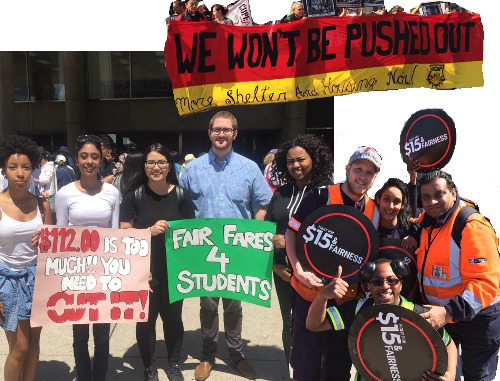 In the Canadian mayoral system, where the council remains the supreme decision-maker and the mayor is considered first-among-equals within a legislative body, local governments encounter their own unique set of governance and administrative challenges – as was illustrated by the stripping-away of Rob Ford’s mayoral powers in 2014 (cbc 2013). For instance, beyond new and independent revenue-raising sources, enhanced collection and enforcement of municipal fines and charges could go a long way in recuperating the estimated $1-billion in outstanding charges across Ontario municipalities (Cote and Fenn 2014). But municipalities cannot go it alone in order to resolve issues related to climate change, public transportation, housing, social services and wastewater. These challenges require developing new intergovernmental planning capacities with dedicated funding to launch a national transit strategy and clean water fund, community development strategies in self-governing northern and First Nations communities and new investments in social services provisioning and infrastructure. The only realistic starting point for the Province of Ontario (as much as the Government of Canada) is to recognize that municipal downloading and austerity have created more problems than they have solved. The unwillingness of federal and provincial governments to extend governance autonomy and revenue powers to municipalities prevents local governments from democratically establishing public policies that are a counter to neoliberalism. In practice, this structural incapacity reinforces capital mobility avoiding any centralization or harmonization of policies safeguarding against the potential market-inhibiting “abuses of democracy.”
In the Canadian mayoral system, where the council remains the supreme decision-maker and the mayor is considered first-among-equals within a legislative body, local governments encounter their own unique set of governance and administrative challenges – as was illustrated by the stripping-away of Rob Ford’s mayoral powers in 2014 (cbc 2013). For instance, beyond new and independent revenue-raising sources, enhanced collection and enforcement of municipal fines and charges could go a long way in recuperating the estimated $1-billion in outstanding charges across Ontario municipalities (Cote and Fenn 2014). But municipalities cannot go it alone in order to resolve issues related to climate change, public transportation, housing, social services and wastewater. These challenges require developing new intergovernmental planning capacities with dedicated funding to launch a national transit strategy and clean water fund, community development strategies in self-governing northern and First Nations communities and new investments in social services provisioning and infrastructure. The only realistic starting point for the Province of Ontario (as much as the Government of Canada) is to recognize that municipal downloading and austerity have created more problems than they have solved. The unwillingness of federal and provincial governments to extend governance autonomy and revenue powers to municipalities prevents local governments from democratically establishing public policies that are a counter to neoliberalism. In practice, this structural incapacity reinforces capital mobility avoiding any centralization or harmonization of policies safeguarding against the potential market-inhibiting “abuses of democracy.”
Of course, there is also a political imperative to do more thinking about alternative responses to the challenges confronting municipalities informed by labour, community groups, First Nations, municipal associations and other civil society groups. “Rights to the city” campaigns in North America, for example, are focusing on free public transit, social housing and public spaces that are protected from commercialization and anti-poverty initiatives. David Harvey (2008: 40) suggests adopting
“the right to the city as both working slogan and political ideal, precisely because it focuses on the question of who commands the necessary connection between urbanization and surplus production and use. The democratization of that right, and the construction of a broad social movement to enforce its will is imperative if the dispossessed are to take back the control which they have for so long been denied, and if they are to institute new modes of urbanization.”
Of course, only new organizational capacities will make such ideas politically viable. As such, the goal over the long term should include dedicated organizing strategies intent on creating new inroads into spaces currently seen as private. These initiatives would need to emphasize the social value of extending public services and shift the debate from focusing solely on individual consumerist needs met through the market and tax cuts, to creating livable cities that offer decent employment, public spaces, universal public services and climate change-informed development.
Making the case for an expanded public sector counters the prevailing orthodoxy of neoliberalism – one that challenges private accumulation as the engine of economic growth – and raises a set of demands for non-commodified labour and services. This means not only expanding the redistributive role of the state, but also taking the lead in ensuring access to housing, public transit, community centres and other social services irrespective of urban and regional boundaries. Reducing public spending will increase unemployment, weaken consumption and exacerbate income inequality, along with reinforcing ethno-racial and gendered labour market/life insecurities. One of the silver linings of the recession has been the fact that governments can borrow money at historically low interest rates, making large-scale public reinvestments feasible. Likewise, with the cash holdings of non-financial corporations increasing faster in Canada than anywhere else in the G7 since the mid-2000s, it is clear that corporate hordes of “dead money” – to borrow a phrase from former Bank of Canada governor Mark Carney – have also become an economic and social liability, particularly in the context of the private sector’s unwillingness to create new jobs.
Research by Jim Stanford has shown that “since the first of several rounds of business tax reforms and reductions were implemented in 1988, business investment has declined by 1 full percentage point of GDP – even though after-tax business cash-flow has increased (in part as a direct result of the tax reforms) by 3 to 4 percentage points of GDP.” This led Stanford (2011: 3-4) to conclude: “As a means of stimulating growth, employment and even private business spending the historical evidence suggests that business tax cuts are both economically ineffective and distributionally regressive.” Instead of using the extra cash to boost investments in machinery, equipment, new plants, new hires and research and development, nearly half of all profits have gone to boosting shareholder dividends. As such, the rate of investment in new machinery, equipment and people over the past decade has declined in lockstep with lower tax rates, putting Canada dead last among peer countries when it comes to new investments in research and development (CLC 2012; Conference Board of Canada 2014). By the end of 2014 corporations held some $680-billion on hand, larger than Canada’s national debt, during which time new public investments as a percentage of GDP fell from the average of 2–3 per cent in the 1960s and 1970s to around 0.5 per cent since the mid-1990s, where it has remained ever since. Reallocating this “dead money” away from financing tax cuts and toward new public investments in social and physical infrastructure through a reversal of the tax cuts that have been a hallmark of neoliberal governments would provide both a direct economic stimulus and job growth in the face of the private sector’s unwillingness to spend. Thus the focus ought to be on enhancing public revenue by rebuilding stable, long-term funding streams rather than that onesize-fits-all diktat of austerity-driven expenditure restraint and service cuts alone.
In the absence of organized civic political parties (they are effectively banned in Ontario by the Municipal Elections Act), trade union and community activists must fill that void. One of the few exceptions in speaking out against municipal service level and staff cuts has been radical sections of the anti-poverty movement. In the face of continued gentrification across Toronto (partly driven by the property tax that is tied to market value), falling housing affordability and a looming real estate bubble, many working poor families continue to fall deeper into debt amidst increasing social insecurity in what is ultimately a city divided by race and class (Hulchanski 2010; Walks and Maaranen 2008). It is not clear that the moral outrages at the service cuts that have been the dominant political response of various civil society organizations and some unions will lead organizationally to anything new and more effective. A long period of stagnation could heighten the municipal crisis as poorly funded cities continue their social polarization and decline. The political coalitions that have arisen in Toronto (and across Ontario) to fight the cuts over the last two decades have been unable to reverse these processes, although they have certainly slowed it down in some important ways.
Some of the most notable of these are found in locally rooted union and community-based movements. This includes Local 79 and 416 campaigns for the extension of public services; Toronto Hydro workers’ struggles against privatization; Amalgamated Transit Union Local
113’s We Move Toronto campaign for the expansion of public transit; and the Toronto and York Region Labour Council’s Retirement Security for Everyone campaign. Others include the Good Jobs For All Coalition, an alliance of community, labour, social justice, youth and environmental organizations challenging low-waged and precarious work across the city and region; the Ontario Coalition Against Poverty and the Stop the Cuts campaign; the Idle No More and Defenders of the Land housing and Indigenous rights movements; Toronto Environmental Alliance efforts around waste privatization, opposition to the Line 9 oil pipeline between Ontario and Quebec and climate justice; Ontario Health Coalition efforts against cuts to healthcare funding and public–private partnerships; the Workers’ Action Centre-led campaign for a $15 Living Wage; and No One Is Illegal struggles around migrant justice, just to name a few.
While it is still too early to tell what will amount of these movements and campaigns over the long term, these labour and community-based responses to social injustice are beginning to rebuild a democratic praxis from below that challenges market rule. Activists continue to struggle with new ways of understanding the relationship of movements to one another, their shared interests and how to build solidaristic political capacities wherein alternative and oppositional political views may emerge. •
This is an excerpt from Megacity Malaise, available from Fernwood Publishing.


